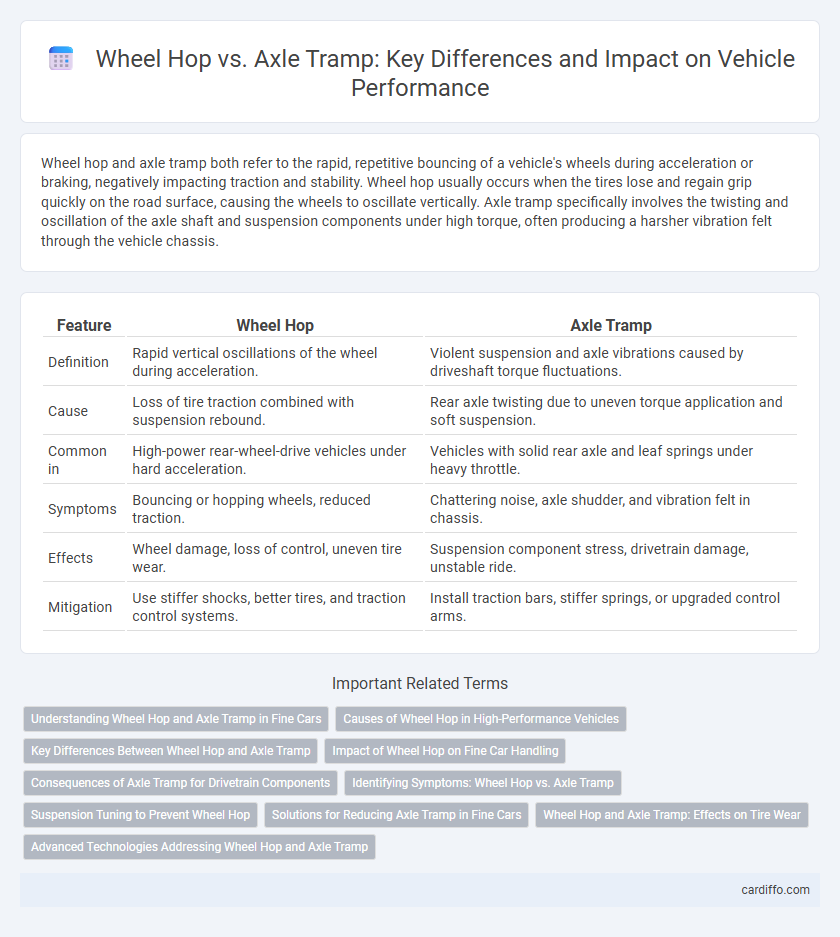Wheel hop and axle tramp both refer to the rapid, repetitive bouncing of a vehicle's wheels during acceleration or braking, negatively impacting traction and stability. Wheel hop usually occurs when the tires lose and regain grip quickly on the road surface, causing the wheels to oscillate vertically. Axle tramp specifically involves the twisting and oscillation of the axle shaft and suspension components under high torque, often producing a harsher vibration felt through the vehicle chassis.
Table of Comparison
| Feature | Wheel Hop | Axle Tramp |
|---|---|---|
| Definition | Rapid vertical oscillations of the wheel during acceleration. | Violent suspension and axle vibrations caused by driveshaft torque fluctuations. |
| Cause | Loss of tire traction combined with suspension rebound. | Rear axle twisting due to uneven torque application and soft suspension. |
| Common in | High-power rear-wheel-drive vehicles under hard acceleration. | Vehicles with solid rear axle and leaf springs under heavy throttle. |
| Symptoms | Bouncing or hopping wheels, reduced traction. | Chattering noise, axle shudder, and vibration felt in chassis. |
| Effects | Wheel damage, loss of control, uneven tire wear. | Suspension component stress, drivetrain damage, unstable ride. |
| Mitigation | Use stiffer shocks, better tires, and traction control systems. | Install traction bars, stiffer springs, or upgraded control arms. |
Understanding Wheel Hop and Axle Tramp in Fine Cars
Wheel hop in fine cars occurs when the tires rapidly oscillate during acceleration or braking, causing loss of traction and reduced handling performance. Axle tramp refers to the violent up-and-down movement of the rear axle, typically due to stiff suspension or inadequate traction control, leading to vibrations and instability. Understanding the distinction between wheel hop and axle tramp helps in optimizing suspension tuning and improving vehicle stability for a smoother, safer ride.
Causes of Wheel Hop in High-Performance Vehicles
Wheel hop in high-performance vehicles primarily results from rapid torque fluctuations causing the tires to lose and regain traction repeatedly. Contributing factors include stiff suspension setups, insufficient tire grip, and axle shaft elasticity that create oscillations during hard acceleration or braking. Addressing wheel hop requires optimizing suspension geometry, using compliant bushings, and selecting tires with high friction coefficients to maintain consistent contact with the road surface.
Key Differences Between Wheel Hop and Axle Tramp
Wheel hop occurs when the tires rapidly lose and regain traction during acceleration or braking, causing a bouncing motion of the wheels. Axle tramp involves the rear axle oscillating violently due to the locking and unlocking of the rear suspension components under high torque. The key difference lies in the affected components: wheel hop primarily affects tire contact with the road, while axle tramp involves the entire rear axle assembly's motion and suspension dynamics.
Impact of Wheel Hop on Fine Car Handling
Wheel hop significantly degrades fine car handling by causing rapid, repetitive vertical oscillations at the tire-road interface, reducing traction and stability during acceleration and cornering. This phenomenon leads to inconsistent grip, increased tire wear, and diminished driver control, especially on high-performance or finely tuned suspension systems. Mitigating wheel hop through suspension upgrades or traction control systems enhances precise handling response and improves overall vehicle dynamics.
Consequences of Axle Tramp for Drivetrain Components
Axle tramp generates excessive vibrations and oscillations in the drivetrain, leading to premature wear of U-joints, driveshaft, and differential gears. This relentless stress can cause metal fatigue, resulting in cracked or broken axles and reduced component lifespan. Severe axle tramp may also compromise wheel bearing integrity and cause driveline misalignment, increasing maintenance costs and reducing vehicle reliability.
Identifying Symptoms: Wheel Hop vs. Axle Tramp
Wheel hop manifests as rapid, oscillating wheel movement during acceleration or braking, often accompanied by a chattering or banging noise and noticeable vibration in the vehicle. Axle tramp presents as a rhythmic, pounding sensation from the rear axle, typically caused by excessive torque winding and rear suspension issues, resulting in uneven tire wear and loss of traction. Differentiating these symptoms requires analyzing the frequency of vibration, noise characteristics, and the driving conditions under which the issues occur.
Suspension Tuning to Prevent Wheel Hop
Suspension tuning to prevent wheel hop involves optimizing spring rates, shock absorber damping, and anti-roll bar stiffness to maintain consistent tire contact during acceleration. Adjusting control arm geometry and installing traction bars help reduce axle tramp by minimizing axle wrap and wheel movement. Properly calibrated suspension components improve traction, enhance vehicle stability, and reduce drivetrain stress caused by rapid oscillations.
Solutions for Reducing Axle Tramp in Fine Cars
Reducing axle tramp in fine cars involves upgrading suspension components such as adding traction bars or ladder bars to improve axle control under acceleration. Installing air or coilover shocks with adjustable damping helps absorb vibrations that cause axle tramp, enhancing ride quality. Optimizing tire pressure and ensuring balanced weight distribution further minimizes wheel hop and traction loss for smooth power delivery.
Wheel Hop and Axle Tramp: Effects on Tire Wear
Wheel hop and axle tramp both cause uneven tire wear due to rapid oscillations of the suspension, but wheel hop produces more intense, high-frequency impacts leading to accelerated tire degradation. Tire sidewalls experience increased stress during wheel hop, resulting in faster tread wear and potential sidewall damage compared to the relatively slower, repetitive forces seen in axle tramp. Controlling wheel hop with traction bars or adjustable shocks reduces tire wear by stabilizing the wheel's movement and minimizing excessive slippage.
Advanced Technologies Addressing Wheel Hop and Axle Tramp
Advanced suspension systems employ adaptive damping technologies and electronic control units to dynamically counteract wheel hop and axle tramp, enhancing ride quality and traction under varying driving conditions. Utilizing sensors and actuators, these systems detect oscillations and modulate suspension stiffness in real-time, minimizing tire slip and preventing damage to driveline components. Integration of active anti-roll bars and predictive algorithms further optimizes vehicle stability, improving performance and safety on both road and off-road terrains.
Wheel hop vs Axle tramp Infographic

 cardiffo.com
cardiffo.com